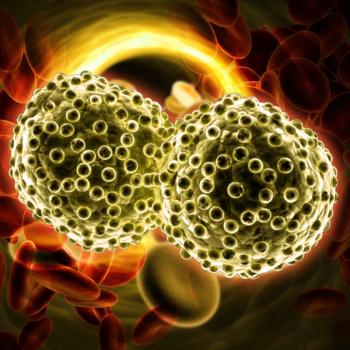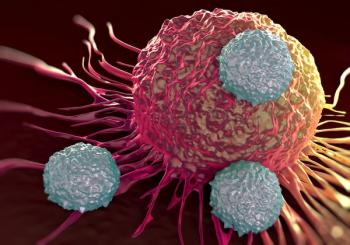
- ONCOLOGY Vol 16 No 10
- Volume 16
- Issue 10
Optimizing the Treatment of Anemia in Cancer Patients
Cancer-related anemia, in addition to having detrimental effects on quality of life and adding the risk and inconvenience of blood transfusions, may also be associated with decreased survival or time to progression. Yet
ABSTRACT: Cancer-related anemia, in addition to having detrimental effects on qualityof life and adding the risk and inconvenience of blood transfusions, may also beassociated with decreased survival or time to progression. Yet despiteincreasing awareness of the value of treating cancer-related anemia, over 60% ofUS cancer patients receiving chemotherapy who have hemoglobin values below 10 g/dLare not treated for this condition. Current treatment options include red bloodcell transfusions, iron supplementation for iron deficiency, or erythropoieticagents, including recombinant human erythropoietin (rHuEPO) and darbepoetin alfa(Aranesp). The articles in this supplement describe the basic scientificresearch and clinical development of darbepoetin alfaanother safe, effective,and approved treatment for chemotherapy-induced anemia. [ONCOLOGY 16(Suppl 11):9-12,2002]
Anemia is associated with many symptoms, including exhaustion, weakness,impaired concentration, dyspnea, respiratory distress, lethargy, and fatigue.Fatigue is the symptom generally identified as the most significant contributoryfactor to poor quality of life in patients with cancer.[3-7] In addition, somestudies suggest that anemia may reduce the efficacy of anticancer therapy.[8-12]An association between anemia and poorer therapeutic outcome and survivalfollowing radiotherapy and/or chemotherapy has been documented in patients withsome malignancies.[8,9,11,13]
Etiology
The etiology of anemia in the oncology setting is multifactorial. The releaseof cytokines in response to the inflammatory or neoplastic process reduces theerythrocyte lifespan and impairs erythroid colony formation, erythropoietinproduction, and iron reutilization. Anemia may also be induced by acute andchronic blood loss, particularly among patients with gastrointestinal, head andneck, genitourinary, and uterine cancers.[2,14] Other factors, such asreplacement of active bone marrow in advanced metastatic carcinoma orhematologic malignancies, may destroy progenitor cells, induce fibrotic or fattyreplacement, and contribute to anemia.
Both chemotherapy and radiotherapy can induce or further exacerbate anemia bysuppressing erythropoiesis.[2,14] In addition, chemotherapy can reduceerythropoietin production by direct effects on the renal tubules, decrease thesensitivity of the hematopoietic system to erythropoietin, and cause stem celldamage, or destroy mature hematopoietic cells. Chemotherapy may also lead tolong-term myelodysplasia or microangiopathy. Radiotherapy may damage bone marrowstem cells, and lead to transient or sustained anemia as these cells have alimited capacity to repair such damage.[2]
Treatment
Until recently, anemia that was not severe or life-threatening was consideredof little consequence and was frequently untreated. However, increasingrecognition that the treatment of mild-to-moderate anemia can yield clinicallysignificant improvements in patient health-related quality of life has resultedin advances in the palliative management of cancer. The statisticallysignificant correlation of hemoglobin increase and improved quality of life,independent of the tumor response to therapy, clearly demonstrates the impact ofimproving hemoglobin levels in anemic patients with cancer.[6,15,16]
Current treatment options for patients with anemia and malignant diseaseinclude red blood cell transfusions, iron supplementation for iron deficiency,or erythropoietic agents, including epoetin alfa (Epogen, Procrit) anddarbepoetin alfa (Aranesp).[2,17] Red blood cell transfusions provide animmediate benefit in the case of life-threatening or severe symptomatic anemia,but are associated with inherent risks and inconvenience. Although associatedwith a slower onset of efficacy, erythropoietic agents are safer thantransfusion, and are effective and widely used to treat chemotherapy-inducedanemia.
Recombinant human erythropoietin (rHuEPO) was initially studied in anemiccancer patients receiving chemotherapy based on the observation that endogenouserythropoietin concentrations are inadequate for the degree of anemia, and thatthe administration of chemotherapy may blunt the erythropoietin response toanemia. In one of the first published reports of rHuEPO treatment in anemiccancer patients receiving chemotherapy, Henry and Abels[18] reported resultsfrom a series of large, placebo-controlled trials in which rHuEPO wasadministered at 150 U/kg three times per week for 12 weeks, with dose increasespermitted after 8 weeks. The results showed that rHuEPO therapy couldalleviate the need for blood transfusions in anemic cancer patients receivingchemotherapy (combined platinum- and nonplatinum-based chemotherapy groups) inthe second and third month of therapy. In addition, a statistically significantincrease in hemoglobin concentration relative to placebo both in patientsreceiving non-cisplatin-based chemotherapy as well as in patients receivingcisplatin-based chemotherapy was observed, with 58% and 48% of patients,respectively, achieving a 6-point hematocrit increase from baseline in theabsence of a transfusion.
Numerous controlled and uncontrolled studies, including several large UScommunity-based studies, have confirmed these findings. In a study of over 2,000anemic patients with nonmyeloid malignancies receiving chemotherapy treated with
Weight-Based vs Fixed Doses
To date, all of the clinical studies of darbepoetin alfa have evaluatedweight-based doses; however, studies of rHuEPO suggest that weight-based dosesproduce similar efficacy to a fixed dose calculated for a 70-kg patient. In thissupplement, Nelson Jumbe and coworkers report a pharmacokinetic/pharmacodynamicmodel, constructed using data from clinical trials of darbepoetin alfa, in whichweight-based vs fixed-dose administration of darbepoetin alfa was evaluated. Thepredictions of the model are validated against clinical trial data withweight-based doses. The model predicts that the response to a fixed dose of 200µg every 2 weeks would be similar to that of a weight-based dose of 3.0 µg/kgevery 2 weeks. The authors conclude that future work to confirm this hypothesisis warranted.
However, given the clinical experience of the transition from weight-baseddosing for rHuEPO, the results of the model are compelling and confirm that apatient’s body weight is only one aspect of the interpatient variabilityobserved in patients treated with erythropoietic agents. Given the widetherapeutic index for this class of drugs, fixed dosing appears to be both aneffective and more convenient approach to treatment with less product waste.
Dose Range and Effectson Patient Subgroups:A Meta-Analysis
To further investigate the therapeutic dose range and possibility ofvariability in the response to darb-epoetin alfa in patient subpopulations,Johan Vansteenkiste and coworkers report on a meta-analysis of data from fourcompleted clinical studies of darbepoetin alfa. The effectiveness of darbepoetinalfa was evaluated over a range of doses, and the results of the analysisdemonstrated a consistent dose-response relationship for darbepoetin alfa withrespect to hemoglobin parameters and transfusion incidence. Even the low-dosegroup (average weekly dose of less than 1.5 µg/kg) demonstrated differences vsplacebo and vs the higher-dose groups (mid-dose group: 1.5 to 2.25 µg/kg/wk;high-dose group: > 2.25 µg/kg/wk), whether measured by change inhemoglobin from baseline or as the proportion of patients achieving ahematopoietic response.
While a dose-response relationship was observed for hemoglobin end points, norelationship was seen for transfusion requirements (although a substantialtreatment effect was observed compared with placebo). The authors suggest thatthese findings could potentially be explained by the hypothesis that while lowerdoses stabilize hemoglobin concentrations, the relative differences inhemoglobin change between the dose groups are not of adequate magnitude toimpact on the transfusion risk.
Importantly, this article also reports on a series of analyses that inform usabout the relative treatment effect of darbepoetin alfa in specific patientsubpopulations. No differences in the safety or efficacy of darb-epoetin alfawere demonstrated for patients based on age, sex, baseline hemoglobinconcentration, chemotherapy type (platinum vs nonplatinum), or tumor type (solidvs lymphoproliferative malignancies). Thus, no patient subgroups have beenidentified that may require alternative dosing algorithms. Notably, theseanalyses demonstrated that even patients initiated on darbepoetin alfa therapyat hemoglobin concentrations above 10 g/dL realized both a significanttransfusion benefit as well as a hemoglobin benefit, relative to placebo-treatedpatients. These results indicate that initiation of darbepoetin alfa treatmentin patients with hemoglobin values > 10 g/dL can provide anappreciable treatment effect.
Summary
The introduction of rHuEPO a decade ago revolutionized the treatment ofanemia in patients receiving chemotherapy. Both mental and physical function areadversely affected by even mild degrees of anemia. Patients and their practicingphysicians are now more aware of the detrimental effects of anemia onhealth-related quality of life and the potential risks and inconvenienceassociated with blood transfusions. Furthermore, anemia may be associated withdecreased survival or a decreased time to progression in cancer patients.However, despite increasing recognition of the value of treating anemia, over60% of anemic cancer patients receiving chemotherapy in the United States (andan even higher proportion in regions outside of the United States) withhemoglobin values less than 10 g/dL are not treated.
This supplement includes a series of important articles describing the basicscientific research and thorough clinical development of darbepoetin alfa.Darbepoetin alfa is a safe, effective, and approved treatment forchemotherapy-induced anemia. With the increased awareness of anemia and itsquality-of-life consequences in the cancer patient, agents like rHuEPO, and nowdarbepoetin alfa, offer the oncologist a safe and effective option to reversethe effects of anemia. This supplement highlights the continuing clinicalresearch efforts to optimize the dose and schedule of darbepoetin alfa,affording patients, caregivers, and providers greater freedom in the managementof anemia.
References:
1. Groopman JE, Itri LM: Chemotherapy-induced anemia in adults: Incidence andtreatment. J Natl Cancer Inst 91:1616-1634, 1999.
2. Mercadante S, Gebbia V, Marrazzo A, et al: Anaemia in cancer:Pathophysiology and treatment. Cancer Treat Rev 26:303-311, 2000.
3. Curt CA: Impact of fatigue on quality of life in oncology patients. SeminHematol 37(4 suppl 6):14-17, 2000.
4. Vogelzang NJ, Mani S, Schilsky RL, et al: Phase II and pharmacodynamicstudies of pyrazine diazohydroxide (NSC 361456) in patients with advanced renaland colorectal cancer. Clin Cancer Res 4(4):929-934, 1998.
5. Cella D: Factors influencing quality of life in cancer patients: Anemiaand fatigue. Semin Oncol 25(3 suppl 7):43-46, 1998.
6. Gabrilove JL, Cleeland C, Livingston RB, et al: Clinical evaluation ofonce-weekly dosing of epoetin alfa in chemotherapy patients: Improvements inhemoglobin and quality of life are similar to three-times-weekly dosing. J ClinOncol 19:2875-2882, 2001.
7. Littlewood TJ, Bajetta E, Nortier J, et al: Effects of epoetin alfa onhematologic parameters and quality of life in cancer patients receivingnonplatinum chemotherapy: Results of a randomized, double-blind,placebo-controlled trial. J Clin Oncol 19:2865-2874, 2001.
8. Glaser CM, Millesi W, Kornek GV, et al: Impact of hemoglobin level and useof recombinant erythropoietin on efficacy of preoperative chemoradiation therapyfor squamous cell carcinoma of the oral cavity and oropharynx. Int J RadiatOncol Biol Phys 50:705-715, 2001.
9. Caro JJ, Salas M, Ward A, et al: Anemia as an independent prognosticfactor for survival in patients with cancer: A systemic, quantitative review.Cancer 91:2214-2221, 2001.
10. Grogan M, Thomas GM, Melamed I, et al: The importance of hemoglobinlevels during radiotherapy for carcinoma of the cervix. Cancer 86:1528-1536,1999.
11. Lee WR, Berkey B, Marcial V, et al: Anemia is associated with decreasedsurvival and increased locoregional failure in patients with locally advancedhead and neck carcinoma: A secondary analysis of RTOG 85-27. Int J Radiat OncolBiol Phys 42:1069-1075, 1998.
12. Dubray B, Mosseri V, Brunin F, et al: Anemia is associated with lowerlocal-regional control and survival after radiation therapy for head and neckcancer: A prospective study. Radiology 201:553-558, 1996.
13. Fein DA, Lee WR, Hanlon AL, et al: Pretreatment hemoglobin levelinfluences local control and survival of T1-T2 squamous cell carcinomas of theglottic larynx. J Clin Oncol 13:2077-2083, 1995.
14. Erslev AJ: Erythropoietin and anemia of cancer. Eur J Haematol64:353-358, 2000.
15. Glaspy J, Bukowski R, Steinberg D, et al: Impact of therapy with epoetinalfa on clinical outcomes in patients with nonmyeloid malignancies during cancerchemotherapy in community oncology practice. J Clin Oncol 15:1218-1234, 1997.
16. Demetri GD, Kris M, Wade J, et al: Quality-of-life benefit inchemotherapy patients treated with epoetin alfa is independent of diseaseresponse or tumor type: Results from a prospective community oncology study. JClin Oncol 16:3412-3425, 1998.
17. Ludwig H: Epoetin in cancer-related anaemia. Nephrol Dial Transplant14:85-92, 1999.
18. Henry DH, Abels RI: Recombinant human erythropoietin in the treatment ofcancer and chemotherapy-induced anemia: Results of double-blind and open-labelfollow-up studies. Semin Oncol 21:21-28, 1994.
19. Kotasek D, Albertsson M, Mackey J, et al: Randomized, double-blind,placebo-controlled, dose-finding study of darbepoetin alfa administered onceevery 3 (Q3W) or 4 (Q4W) weeks in patients with solid tumors. Proc Am SocClin Oncol 21:356a, 2002.
20. Smith RE, Tchekmedyian S, Richards D, et al: Darbepoetin alfa effectivelyalleviates anemia in patients with chronic anemia of cancer: Efficacy andpharmacokinetic results of a dose-escalation study. Proc Am Soc Clin Oncol21:367a, 2002.
21. Vansteenkiste J, Pirker R, Massuti B, et al: Double-blind,placebo-controlled, randomised phase III trial of darbepoetin alfa in lungcancer patients receiving chemotherapy. J Natl Cancer Inst 94:1211-1220, 2002.
Articles in this issue
about 23 years ago
Capecitabine in the Treatment of Advanced Breast Cancerabout 23 years ago
New Directions With Capecitabine Combinations in Advanced Breast Cancerover 23 years ago
Anastrozole Approved for Use in Early Breast Cancerover 23 years ago
US Senate Passes Eliminate Colorectal Cancer Actover 23 years ago
Cigarette Smoking Among Adults United States, 2000over 23 years ago
FDA Approves Kytril for Postoperative Nausea and Vomitingover 23 years ago
Optimal Use of Antiemetics in the Outpatient SettingNewsletter
Stay up to date on recent advances in the multidisciplinary approach to cancer.
































































































